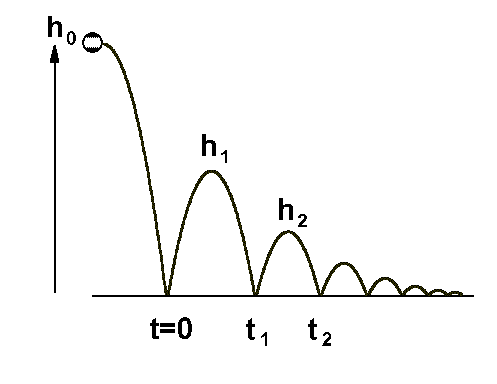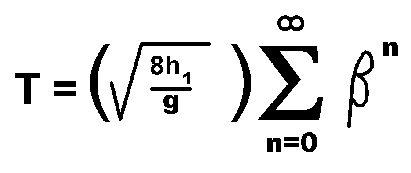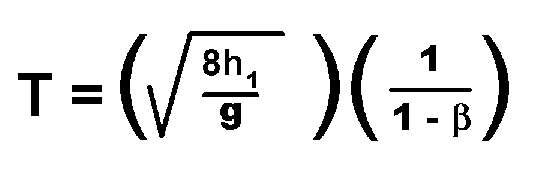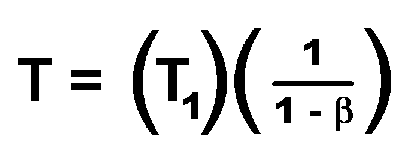Beth Drops a Bouncy Ball Which Bounces Up Again
Zeno's movement paradoxes all have to do with dividing time into ever smaller slices. Nosotros can experimentally realized such a sequence of always-smaller time intervals by watching a billowy ball.

The figure at the correct represents a ball dropped from an initial height h0 . When information technology bounces it loses energy, so that the next bounce height, hone , is smaller. The model used here is that the fraction of free energy lost on each bounce is a abiding, independent of energy.
In the effigy, the ball is given a small horizontal velocity to the correct, and then that it bounces further to the right each time. The horizontal position centrality acts as a time axis because the horizontal velocity remains abiding.
The model implies that each successive bounce is less than the previous bounce past the aforementioned fraction. In the figure, each bounciness is half as loftier as the previous bounce. Nosotros phone call the fraction remaining g , so that
h1 = 1000 h0 .
In classroom give-and-take, we consider another possibility; that the bounce decreases past a constant amount, rather than a abiding fraction. This model readily predicts the number of bounces for the ball to come to residue. However, experiment (dropping the ball from several different heights) quickly shows that this model is not close to the ball'south behavior. Information technology is more accurate to say that the ball looses (for example) half of its acme on the first bounce, no matter that the original meridian from which it was dropped.
With the abiding fraction model, it seems that the ball will require an infinite number of bounces to come to rest. Intuition says that it will have an infinite amount of time for this to occur. Assay still, shows that in this model, the ball tin make an infinite number of bounces in a finite corporeality of time. The reason is that the time betwixt bounces decreases as the bounciness height decreases.
The thought that the brawl executes an infinite number of bounces in a finite amount of time is possibly the most interesting response to Zeno's paradoxes. We take experimental prove that an infinite number of events tin occur in a finite amount of time. Mathematically, nosotros have utilize the fact that (for some cases) the sum of an space number of terms is a finite number.
Using the labels in the diagram, we prove that the time from t=0 to t=t1 is given past
(t1 - 0) = (8h1/thousand)(1/2)
In words, the bounce-to-bounce time is proportional to the square root of the bounce height.
Using the fact that htwo = g hane, we see that
(t2 - t1) = ( chiliad 8h1/g)(1/2) = (t1 - 0)( 1000 )(1/2)
Adding up all the bounce-to-bounce times (from northward=0 to infinity) gives the full time to come to rest:

With a ( yard )(1/2) divers as b , this becomes

and the sum has the result

We usually determine g by measuring the initial drop height and the start bounce height, hane , and so that the equation above is a natural way to express the futurity to rest. An alternative is to notice that the time between the first and the second bounces is simply the first term in that expression, so that

From this betoken of view, b is all-time measured by measuring the time for the 2nd bounce and the first for the second bounciness: b is the ratio of those times. In this way, the time to come to balance is predicted from the times for the first 2 bounces.
In a later exercise, nosotros consider the disuse of the motion of a pendulum. To a adept approximation, the pendulum also loses a constant fraction of its amplitude with each swing. The difference is that the period of the pendulum does not go to cipher every bit the amplitude decreases - it remains nearly constant. Because of this the model predicts an space numbers of swings occur earlier the pendulum comes to residual. This beliefs manifests itself in the (approximately) exponential disuse of the pendulum amplitude.
godfreyrainglevers.blogspot.com
Source: https://www.millersville.edu/physics/experiments/045/
0 Response to "Beth Drops a Bouncy Ball Which Bounces Up Again"
Post a Comment